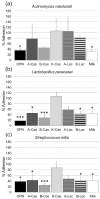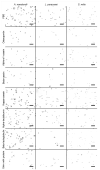Prevention of Initial Bacterial Attachment by Osteopontin and Other Bioactive Milk Proteins
- PMID: 36009469
- PMCID: PMC9405890
- DOI: 10.3390/biomedicines10081922
Prevention of Initial Bacterial Attachment by Osteopontin and Other Bioactive Milk Proteins
Abstract
A considerable body of work has studied the involvement of osteopontin (OPN) in human physiology and pathology, but comparably little is known about the interaction of OPN with prokaryotic cells. Recently, bovine milk OPN has been proposed as a therapeutic agent to prevent the build-up of dental biofilms, which are responsible for the development of caries lesions. Bioactive milk proteins are among the most exciting resources for caries control, as they hamper bacterial attachment to teeth without affecting microbial homeostasis in the mouth. The present work investigated the ability of OPN to prevent the adhesion of three dental biofilm-forming bacteria to saliva-coated surfaces under shear-controlled flow conditions in comparison with the major milk proteins α-lactalbumin, β-lactoglobulin, αs1-casein, β-casein and κ-casein, as well as crude milk protein. OPN was the most effective single protein to reduce the adhesion of Actinomyces naeslundii, Lactobacillus paracasei subsp. paracasei and Streptococcus mitis. β-casein and crude milk protein also had a pronounced effect on all three species, which suggests binding to different microbial surface structures rather than the blocking of a specific bacterial adhesin. Bioactive milk proteins show potential to delay harmful biofilm formation on teeth and hence the onset of biofilm-related oral disease.
Keywords: actinomyces; bacterial adhesion; biofilms; caseins; dental caries; lactobacillus; microfluidic device; osteopontin; streptococcus.
Conflict of interest statement
The authors declare no conflict of interest. The funders had no role in the design of the study; in the collection, analyses, or interpretation of data; in the writing of the manuscript, or in the decision to publish the results.
Figures


Similar articles
-
Osteopontin adsorption to Gram-positive cells reduces adhesion forces and attachment to surfaces under flow.J Oral Microbiol. 2017 Oct 11;9(1):1379826. doi: 10.1080/20002297.2017.1379826. eCollection 2017. J Oral Microbiol. 2017. PMID: 29081915 Free PMC article.
-
Osteopontin reduces biofilm formation in a multi-species model of dental biofilm.PLoS One. 2012;7(8):e41534. doi: 10.1371/journal.pone.0041534. Epub 2012 Aug 7. PLoS One. 2012. PMID: 22879891 Free PMC article.
-
Effect of osteopontin on the initial adhesion of dental bacteria.J Nat Prod. 2012 Dec 28;75(12):2108-12. doi: 10.1021/np300514z. Epub 2012 Nov 20. J Nat Prod. 2012. PMID: 23167781
-
Anti-inflammatory mechanisms of bioactive milk proteins in the intestine of newborns.Int J Biochem Cell Biol. 2013 Aug;45(8):1730-47. doi: 10.1016/j.biocel.2013.04.028. Epub 2013 May 6. Int J Biochem Cell Biol. 2013. PMID: 23660296 Review.
-
Milk and oral health.Nestle Nutr Workshop Ser Pediatr Program. 2011;67:55-66. doi: 10.1159/000325575. Epub 2011 Feb 16. Nestle Nutr Workshop Ser Pediatr Program. 2011. PMID: 21335990 Review.
Cited by
-
Bovine milk and milk protein- promotor or inhibitor of bacterial biofilm formation at the tooth surface?BMC Oral Health. 2025 Jul 2;25(1):992. doi: 10.1186/s12903-025-06432-1. BMC Oral Health. 2025. PMID: 40604707 Free PMC article.
-
Osteopontin: Its Properties, Recent Studies, and Potential Applications.Int J Mol Sci. 2025 Jun 19;26(12):5868. doi: 10.3390/ijms26125868. Int J Mol Sci. 2025. PMID: 40565331 Free PMC article. Review.
-
Milk Osteopontin and Human Health.Nutrients. 2023 May 23;15(11):2423. doi: 10.3390/nu15112423. Nutrients. 2023. PMID: 37299387 Free PMC article. Review.
-
Beyond the Biomarker: Unveiling the Multifaceted Role of Osteopontin in Both Physiological and Pathological Processes.Biomedicines. 2024 Apr 30;12(5):982. doi: 10.3390/biomedicines12050982. Biomedicines. 2024. PMID: 38790944 Free PMC article.
-
Inhibitory effect of bovine milk osteopontin on the initial attachment of Streptococcus mutans.JDS Commun. 2024 Apr 20;5(6):535-538. doi: 10.3168/jdsc.2024-0558. eCollection 2024 Nov. JDS Commun. 2024. PMID: 39650014 Free PMC article.
References
-
- Bruun S., Jacobsen L.N., Ze X., Husby S., Ueno H.M., Nojiri K., Kobayashi S., Kwon J., Liu X., Yan S., et al. Osteopontin levels in human milk vary across countries and within lactation period: Data from a multicenter study. J. Pediatr. Gastroenterol. Nutr. 2018;67:250–256. doi: 10.1097/MPG.0000000000002004. - DOI - PubMed
LinkOut - more resources
Full Text Sources
Other Literature Sources
Research Materials

